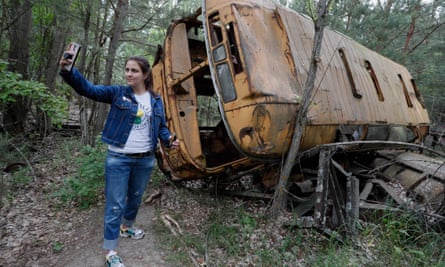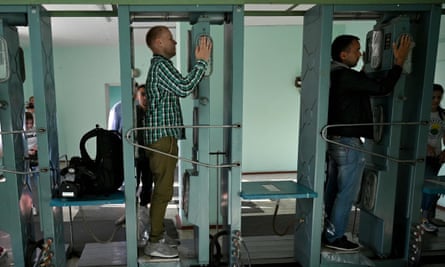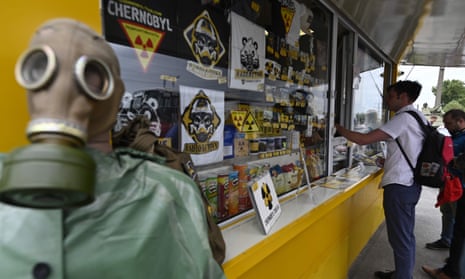Visitors to Chernobyl can now buy jokey “radioactive” ice-cream and $19 canisters of Chernobyl air so they can inhale “the unforgettable smell of abandoned concrete structures of the Soviet Union, the dampness of basements, mixed with the aroma of Pripyat roses”.
Visitor numbers to the region, devastated in 1986 by the worst nuclear accident in history, have been rising over the years. This has been prompted by less dangerous levels of radioactivity and the trend for dark tourism: who needs Venice when you can take a selfie in Pripyat?
But the figures have now skyrocketed thanks to the hit HBO drama Chernobyl. In October 2018, there were 9,083 visitors to the Zone – the 1,000 sq mile exclusion zone around the plant established by Soviet forces soon after the disaster. This October, there were more than 17,000.
The tour company Solo East has seen bookings rise by 45%, although its owner, Sergii Ivanchuk, is not best pleased: “The HBO series did nothing good. The situation is terrible.” He has refused to tweak his tours, saying he is determined to show the real experience of Chernobyl, not one that follows the TV version. He has been taking visitors into the Zone for 19 years and is appalled by the plans of the new Ukrainian president, Volodymyr Zelenskiy, to turn the Zone into a “traveller’s paradise”.
Ivanchuk’s main worry is the rise of vandalism this boom has left in its wake. Everywhere you look, there is penis graffiti. Even love locks – the inane tradition of sweethearts attaching padlocks to structures – has reached Chernobyl. One pound-shop padlock was clipped to the top of the Duga, the giant structure that once scanned the skies over Chernobyl for nuclear missiles. It is now nothing but a rusting climbing frame. At least one tourist has died trying to scale it.

Ivanchuk also despairs at the tour companies cashing in on the show by hawking tasteless souvenirs, from fridge magnets to T-shirts depicting radioactive wolves with glow-in-the-dark eyes. “It should be obvious that a disaster that caused the death of thousands of people should be treated with respect,” he says. “Nobody would think to make gas-chamber magnets and sell them at the entrance to Auschwitz.”
These days, tours make a beeline for “the Bridge of Death”, a chilling presence in the show. Rumour has it that hundreds of city residents gathered there to watch the eerie blue glow of radiation on the night of the explosion, only to later perish (there is no actual evidence of this). And tourists have been posting photos claiming the damage to Pripyat’s buildings was caused by hails of bullets from the Ukrainian army, when in fact the scars and cracks are a result of harsh winters and natural decay.
The huge influx of tourists has also caused ill feeling between Chernobyl’s guides and its “stalkers”, or illegal explorers. While tour companies are raking it in, the stalkers loathe the selfie-snappers they bring. One explorer says: “The influx of tourists is not welcomed by the stalkers, many of whom spend a long time camping there and have done so for many years. A small war is brewing.” One guide was recently attacked.
Stalkers frequently find themselves being blamed for damage in the Zone, something that leaves them furious. Since they are there illegally, they are an easy scapegoat. “Chernobyl,” one told me, “is a home for us, where we can relax, clear our thoughts, play partisans, enjoy the atmosphere of post-apocalypse. We’re stalkers – not vandals.”

Worse than the vandalism, though, is flagrant disrespect. Fans of the show have started visiting the plant’s control rooms to re-enact the scene when the horror of imminent nuclear disaster dawns on the technicians. They are given the same white coats and caps we see on screen, and they perform crass radioactive cosplay for their cameraphones, repeating their favourite line from the show: “Not great, not terrible.” It’s the perfect picture caption.
While three of the plant’s control rooms have long been open, the infamous Reactor No 4, where the explosion happened, has been a no-go zone. Not any more. Since October, fans have been allowed into the space – even though radiation in the room can be 40,000 times higher than normal levels. Tourists must wear protective clothing and can only loiter for five minutes before they have to be removed – and sent off for a radiation check. Who wouldn’t want to Instagram that?

Comments (…)
Sign in or create your Guardian account to join the discussion